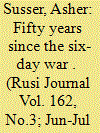|
|
|
Sort Order |
|
|
|
Items / Page
|
|
|
|
|
|
|
| Srl | Item |
| 1 |
ID:
154307


|
|
|
|
|
| Summary/Abstract |
Since the military occupation of the West Bank, East Jerusalem and the Gaza Strip (WBGS) in June 1967, the Palestinian economy has been tightly linked to Israel in an involuntary relationship that can best be characterized as asymmetric in all its aspects. Given the wide economic and developmental gap between the two sides, and according to the basic precepts of neoclassical trade theory, such a relationship was supposed to benefit the less fortunate Palestinian economy more than the more developed and advanced Israeli economy. Over time, the theory predicted a sustained convergence between the two economies should be realized, and the income gap subsequently narrowed. That, however, did not happen, and the economic gap that separates Israel and the occupied Palestinian territories (OPT) continued to grow steadily.1 In 1968, for example, while GDP per capita in Israel (at $1,674) was 10 times higher than that of WBGS, the gap became wider in 2015, with Israeli per capita income (at $35,728) more than 12 times higher than the Palestinian one (at $2,866).2 The absolute gap in GDP per capita between the two economies, however, is much more revealing. While the difference in GDP per capita between Israel and the WBGS was only $1,500 in 1968, the absolute difference jumped to close to $33,000 in 2015. Put differently, while GDP per capita in WBGS increased by only $2,700 over the entire five-decade period, Israel’s GDP per capita increased by more than $34,000 over the same period.
|
|
|
|
|
|
|
|
|
|
|
|
|
|
|
|
| 2 |
ID:
154488


|
|
|
|
|
| Summary/Abstract |
The war of June 1967 was a watershed for the Middle East. In just six days, Israel inflicted upon the Arabs their most humiliating defeat in modern times, perhaps of all time. The great promise of revolutionary Arab nationalism, as espoused by Egypt’s charismatic president, Gamal Abdel Nasser, proved to be no more than an illusion. In this article, Asher Susser explores the lasting consequences of war, arguing that the Arabs have yet to fully recover, 50 years later.
|
|
|
|
|
|
|
|
|
|
|
|
|
|
|
|
| 3 |
ID:
149802


|
|
|
|
|
| Summary/Abstract |
No one can imagine when first looking at Jerusalem, with the light rail, the clean paved roads, the old and new buildings, that just a few blocks away from the European-like main streets, there are Palestinian neighborhoods that look like slums, and not because the buildings are poorly constructed, on the contrary. More than 37% of Jerusalem’s population are Palestinian residents who are living in East Jerusalem neighborhoods that lack basic services, adequate roads and safe sidewalks — when and if they exist.
|
|
|
|
|
|
|
|
|
|
|
|
|
|
|
|
|
|
|
|
|